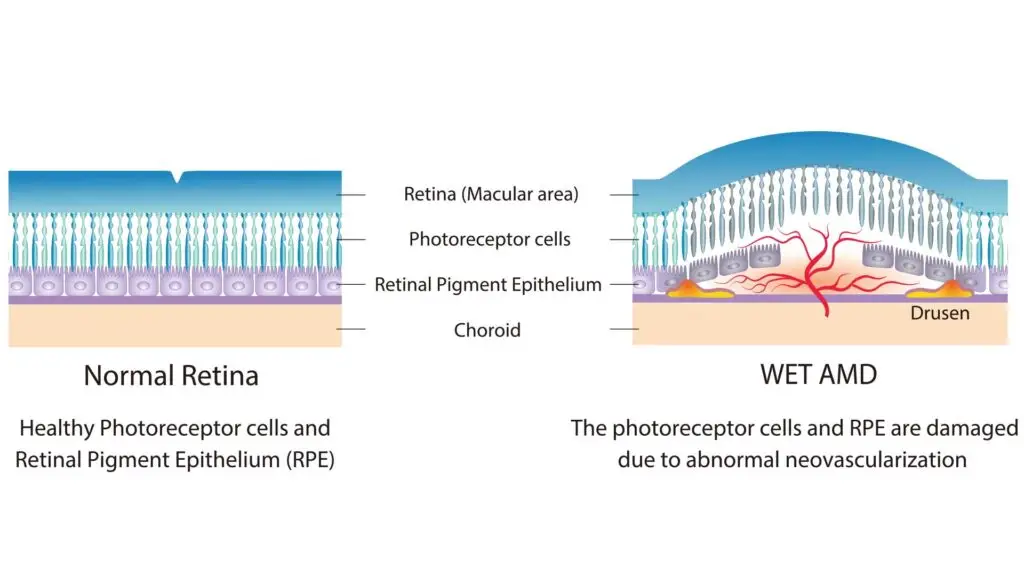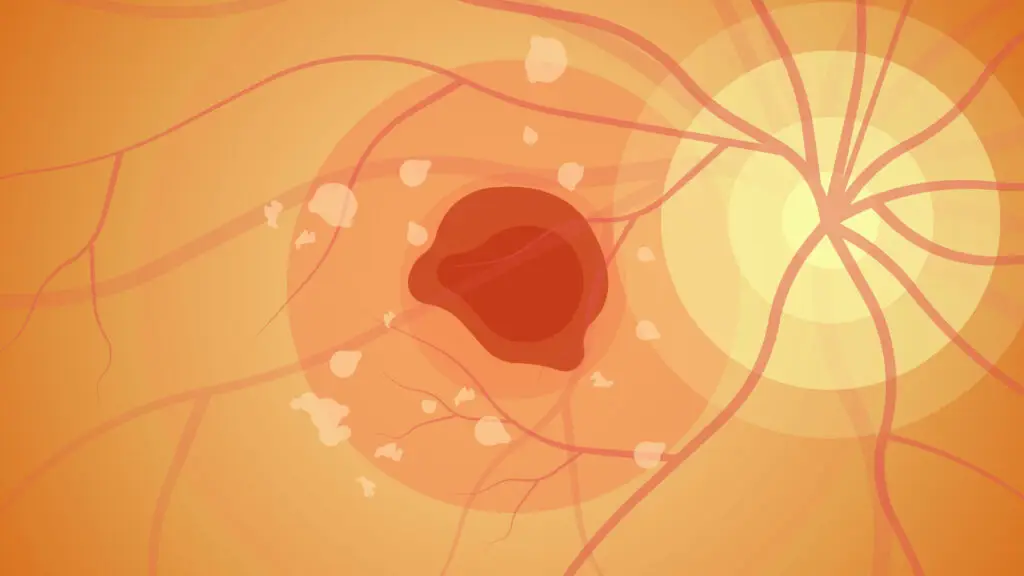
- Medically Reviewed by Mr Mfazo Hove Consultant Ophthalmologist
- Author: Chris Dunnington
- Published: November 14, 2024
- Last Updated: November 7, 2025
At Blue Fin Vision®, our premier eye clinic on Harley Street in London, we often encounter patients seeking information about wet AMD. This complex eye condition, while less common than its dry counterpart, can have a significant impact on vision and quality of life. In this comprehensive guide, we’ll explore what wet AMD is, its causes, symptoms, and the cutting-edge treatments available.
Understanding Wet AMD
Wet Age-Related Macular Degeneration (wet AMD), also known as neovascular AMD, is a severe form of macular degeneration. While it accounts for only about 10-15% of all macular degeneration cases, it’s responsible for 90% of severe vision loss from AMD.
Key Characteristics of Wet AMD
- Rapid Progression: Wet AMD can cause sudden and severe vision loss, often developing over days or weeks.
- Abnormal Blood Vessel Growth: New, fragile blood vessels grow under the retina and macula.
- Leakage and Scarring: These abnormal blood vessels can leak fluid and blood, leading to scarring and rapid vision loss.

Symptoms of Wet AMD
Recognising the symptoms of wet AMD is crucial for early detection and treatment. Common signs include:
- Sudden drop in central vision
- Visual distortions (straight lines appearing wavy)
- Blind spots in central vision
- Decreased colour intensity
- Difficulty reading or recognising faces
- Increased blurriness of central vision
- Perception of a dark or empty area in the centre of vision
It’s important to note that wet AMD can develop rapidly, sometimes over a matter of days or weeks. If you experience any sudden changes in your vision, it’s crucial to seek immediate medical attention.
Causes and Risk Factors of Wet AMD
The primary cause of wet AMD is the growth of abnormal blood vessels, triggered by a protein called vascular endothelial growth factor (VEGF). While the exact reason for this abnormal growth isn’t fully understood, several risk factors have been identified:
- Age: The risk increases significantly after age 50
- Family History: Genetic factors play a role in AMD development
- Smoking: Significantly increases the risk and progression of AMD
- High Blood Pressure: Can contribute to the development of AMD
- Obesity: Increases the risk of AMD progression
- Race: More common in Caucasians
- Previous Dry AMD: People with advanced dry AMD are at higher risk of developing wet AMD
- Diet: Low intake of antioxidants and omega-3 fatty acids may increase risk
- Sun Exposure: Prolonged exposure to UV light may contribute to AMD
At Blue Fin Vision®, our expert ophthalmologists take a comprehensive approach to assess your individual risk factors during thorough eye examinations.

The Impact of Wet AMD on Daily Life
Wet AMD can have a profound impact on a person’s quality of life due to its rapid progression and severe vision loss. Patients may experience:
- Difficulty reading or driving
- Challenges with facial recognition
- Inability to perform detailed tasks
- Loss of independence in daily activities
- Increased risk of falls and accidents
- Emotional distress and depression
Understanding these impacts is crucial for both patients and their families to adapt and seek appropriate support.
Diagnosing Wet AMD
Early detection of wet AMD is key to preserving vision. At Blue Fin Vision®, we use state-of-the-art diagnostic tools to identify and monitor wet AMD:
- Comprehensive Eye Exam: Including visual acuity tests and dilated eye examination
- Optical Coherence Tomography (OCT): Provides detailed images of the retinal layers
- Fluorescein Angiography: Examines blood flow in the retina
- Fundus Photography: Captures images of the retina to track changes over time
- Amsler Grid Test: Helps detect changes in central vision
Our London eye clinic is equipped with the latest technology to ensure accurate diagnosis and monitoring of wet AMD.

Treatment Options for Wet AMD
At Blue Fin Vision®, we offer cutting-edge treatments to manage wet AMD, with anti-VEGF injections being the primary and most effective option. Here’s an overview of the common medications and their typical treatment schedules:
Anti-VEGF Injections
These medications are injected into the eye to block the growth of abnormal blood vessels. The treatment typically begins with a loading phase followed by a maintenance phase, often using a treat-and-extend approach.
- Avastin (bevacizumab)
- Typically administered monthly
- Loading phase: 3 monthly injections
- Maintenance: Monthly injections, with potential for extended intervals based on response
- Lucentis (ranibizumab)
- Initially administered monthly
- Loading phase: 3 monthly injections
- Maintenance: Monthly injections, with potential for treat-and-extend approach
- Eylea (aflibercept)
- Usually starts with monthly injections, then extends to every 2 months
- Loading phase: 3 monthly injections
- Maintenance: Typically follows a treat-and-extend regimen, with intervals up to 12 weeks
- Vabysmo (faricimab-svoa)
- Begins with monthly injections, then transitions to treat-and-extend
- Loading phase: 4 monthly injections
- Maintenance: Treat-and-extend approach, with intervals up to 16 weeks
Treat-and-Extend Approach
The treat-and-extend regimen is a proactive approach that aims to optimise treatment intervals for each patient:
- After the loading phase, the interval between injections is gradually extended if the macula remains dry
- Typical extension: 2-week increments, up to a maximum of 12-16 weeks (depending on the medication)
- If signs of disease activity return, the interval is shortened
This approach helps minimise the number of injections and clinic visits while maintaining effective disease control.
Effectiveness and Monitoring
- Anti-VEGF injections can slow or stop vision loss in most patients, and may even improve vision in some cases
- Regular monitoring with OCT scans and visual acuity tests helps determine the optimal treatment interval for each patient
At Blue Fin Vision®, we tailor the treatment plan to each patient’s individual needs and response, ensuring the most effective management of wet AMD while minimising treatment burden.
Living with Wet AMD: Practical Tips
For those diagnosed with wet AMD, here are some practical tips to help manage the condition:
- Adhere to Treatment: Follow your treatment plan diligently
- Regular Monitoring: Attend all follow-up appointments
- Use Adaptive Devices: Magnifiers and other low vision aids can help with daily tasks
- Modify Your Home: Improve lighting and reduce tripping hazards
- Stay Connected: Join support groups to share experiences and tips with others
- Maintain a Healthy Lifestyle: Eat a balanced diet, exercise regularly, and avoid smoking
The Importance of Early Detection and Treatment

Early detection and prompt treatment are crucial in managing wet AMD and preserving vision. Regular eye exams, especially for those over 50 or with risk factors, can help catch the condition in its early stages when treatment is most effective.
Why Choose Blue Fin Vision® for Wet AMD Care?
At Blue Fin Vision®, our London eye clinic offers:
- Expert Care: Our team of specialist ophthalmologists are leaders in AMD management
- Advanced Technology: We use the latest diagnostic and treatment technologies
- Personalised Treatment: Each patient receives a tailored care plan
- Comprehensive Support: From diagnosis through to long-term management
- Convenient Location: Our Harley Street clinic is easily accessible in central London
Conclusion: Taking Control of Your Eye Health
While a wet AMD diagnosis can be concerning, it’s important to remember that with early detection and appropriate treatment, vision loss can often be slowed or even halted. At Blue Fin Vision®, we’re committed to providing the highest standard of care for wet AMD patients, utilising the latest advancements in eye care to preserve your vision and quality of life.
Don’t wait for symptoms to worsen – if you experience any sudden changes in your vision, seek immediate medical attention. If you’re concerned about wet AMD or it’s been a while since your last eye examination, we encourage you to book an appointment at our London eye clinic.
Remember, your vision is precious. Trust the experts at Blue Fin Vision® to provide comprehensive, state-of-the-art care for all your eye health needs, including the management of wet AMD. Contact us today to schedule your eye examination and take the first step towards protecting your vision for years to come.


